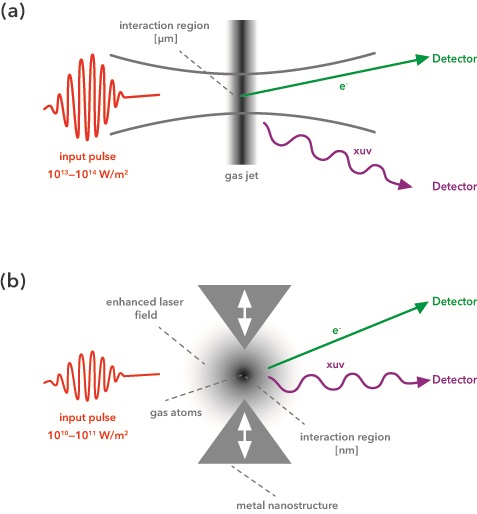20 March 2017
Attoscience physics has made a significantly step forward in the past years and is now considered to be in a mature phase of research and implementation. In parallel, material engineering at the nano-scale has made major improvements as well, permitting scientists to manipulate and engineer systems with nanometric precision. Such advances in both fields have allowed scientists to begin to fathom a new age of atto-nano physics.
In 1894, the father of the Olympic Games, Pierre de Coubertin, introduced the motto ‘Citius, Altius, Fortius’, a saying in Latin that means ‘Faster, Higher, Stronger’. Comparably, in science, researchers are searching to understand Nature by experimentally manipulating and theoretically studying the shortest and fastest physical phenomena at the smallest possible scale. There is a recent interest in, firstly, trying to obtain the highest energetic electrons, and, secondly, generating more brilliant and shortest flashes of light.
In the recent paper published in Reports on Progress in Physics, researchers Dr. M. Ciappina from Max-Planck Institute, in collaboration with ICFO researchers Dr. Alexis Chacon and ICREA Prof at ICFO Maciej Lewenstein as well as scientists from other research centers, present a comprehensive experimental and theoretical overview on physical phenomena that take place when short and intense laser pulses interact with nanosystems. In their study, they address open questions, challenges and prospects for experimental confirmation of theoretical predictions, as well as experiments aimed at characterizing the induced fields and the unique electron dynamics initiated by them with high temporal and spatial resolution.
Among the many scenarios and applications reviewed and cited in the paper, the researchers highlight the changes in the optical and electrical properties in solids induced by a strong and short laser pulse as well as phenomena related to the nanometric electron acceleration. The former, a phenomenon called metallization, can be probed and characterized with recently developed attosecond techniques, thus opening the pathway towards petahertz electronics. The latter can be used for the development of highly directional nanometer-sized ultrafast electron sources.
The technological and fundamental implications of their work is hard to estimate. For instance, the increase in the computer processors speed by several orders of magnitude employing optical switches appears as a certain mid-term prospect.
Now, the coming of this new age for physics has inspired these scientists to re-adapt Coubertin’s motto into the new “atto-nano” motto ‘Citissimus, Maximus, Brevissimus, Minimus’, meaning ‘Fastest, Highest, Shortest, Smallest’. Attosecond physics at the nanometric scale is a rapidly developing and exciting new research field, with many unexpected results still to be revealed and with great potential for future experimental findings and applications.

Citissimus, Maximus, Brevissimus, Minimus
Researchers present an extensive overview on the beginning of a new atto-nano physics age.

Sketch of conventional (a) and plasmonic-enhanced (b) strong field processes













